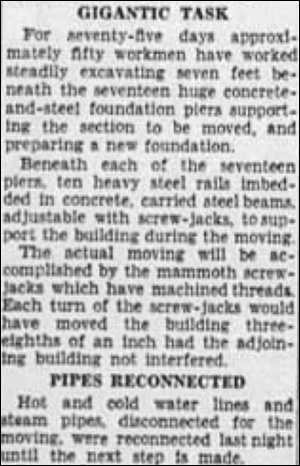 A combination of Google Street View, my own experience, adn newspaper clippings - I could do sites like the one below every day. Next year, I will - the Wednesday Serial will be replaced with something called, well, Clippings. I mentioned that yesterday. A combination of Google Street View, my own experience, adn newspaper clippings - I could do sites like the one below every day. Next year, I will - the Wednesday Serial will be replaced with something called, well, Clippings. I mentioned that yesterday.
Or does it seem like I mentioned it a few minutes ago, because you skipped ahead? <finger wagging>
Random papers, random dates, stories, movie ads. The number of human stories untold and forgotten are in the grains-of-sand-on-the-beach range, you know. We’ve forgotten the big stories; imagine what we’ll never know we forgot.
This one started because I was looking in downtown LA, and saw something I recognized. I passed this place many years ago, and Google Street View still has a nice shot of the old Italian Kitchen restaurant.
It's the sort of miserable vista that speaks of decades of decline and decay.
This was Los Angeles, the old downtown. After the war they decided to build a new downtown elsewhere, and the old one died. The theaters closed, the office buildings emptied out - it was neutron-bomb level devastation, with the old downtown still standing, but depopulated.
Things have changed.
It's the Commercial Exchange Building. Wikipedia:
The 13-story building was completed in 1924. It was designed by the architecture firm of Walker and Eisen. The building has the distinction of having been vertically split to permit widening of Olive Street.
What does that mean, exactly?
To allow the widening of Olive Street in the mid-1930s, a "10-foot slice" was removed from the center of the Commercial Exchange Building and engineers rejoined the remaining halves by sliding the western portion eastward.
Wow.
How the hell did they do that?
I searched the LA Times archive on newspaper.com, and hello, hello:
 |
|
|
 |
|
Mammoth screwjacks pushed the building. All the pipes had to be disconnected. It's . . . it's unimaginable. |
 |
|
|
You see the spot above where the cut was made? It's the only part of the facade today that has one window, instead of two.
Here's a Google Street View from the renovation phase: they used the window at the cut for the debris chute.
Renovation revealed the old doorway:
That simple bas-relief had slumbered for decades under the modern facade:
Today it's been restored to its original 20s style:
Let's look back to the pre-renovation period. The view of abandoned LA:
Now:
The entire block has a sci-fi vibe now, and it actually looks like the renderings they put out to attract investors:
Remarkable.
Oh, across the street?
The restaurants have come and gone, which indicates the area might not be rock-solid yet.
Ah, but why stop there? I was looking for something in Detroit, and ended up wandering around downtown. The renovations are interesting.
A few years ago:
People who grew up since the 60s probably thought this was the way the building looked like, and had always looked like. But then they stripped it:
Why? Why the devil did they do that to the building? The good news: it wasn't permanent. It wasn't the end.
Remarkable.
Next door, around the corner:
Long vacant. Let's go back around the corner to the spot where it abuts the renovated structure:
Battered, abraded, abused - but surely not irredeemable.
If the world had ended in 1967:
Close-up #1:
A frickin' phone. There are still wires underground that led to that number, I'll bet.
The elements have had their way with this place for a while.
But. We've seen things that survived, and prospered. The Park Avenue Building is for sale, and may be renovated; let's hope.
Let's finish with something lost - and that'll take us back to LA.
I ran across this 1936 ad for the Sunkist building.
Don't bother looking for it; they tore it down. Classic LA - modern, stylish, and still romantic. Of course it was leveled. But where did Sunkist go? Since it was the 60s, they built a new HQ far from downtown, and commissioned the latest style.
Says a site about LA architecture: "The Sunkist Headquarters building is a symphony in concrete, declaring its presence on Riverside Drive to all who drive past on the 101 Freeway."
Oh, it certainly does that.
It was designed by A. C. Martin and Associates, a firm with a long and storied history in Los Angeles. In the late 1960s, the firm was busy changing the look of downtown with its Corporate International-style skyscrapers. For Sunkist, A. C. Martin created a low-rise but unquestionably monumental Late Modern-style building of reinforced concrete with recessed windows.
The office building has a Brutalist feel, with its extensive use of concrete and impassive façades, but its off-white color imparts a certain lightness, almost an airy quality. It is a contrast that works—this building is definitely remembered by anyone who has passed by it.
Yes, the same way you always remember a corner where you had a car accident.
Does that building say “California” to you? Bright New Future, Citrus Delights, that sort of thing? Or does it strike you as a mashing machine that slams down hard and pulps anyone who approaches?
This is why we welcomed the return of classical motifs in post-modern architecture. Odd and cartoony as they could be, history was back. The hand of humanity - not the back of the hand, but the open palm - was back. 
Tomorrow: I'm not going to say, because you'll jump ahead. See you then. Or in a minute, if you must. But you don't have to! |